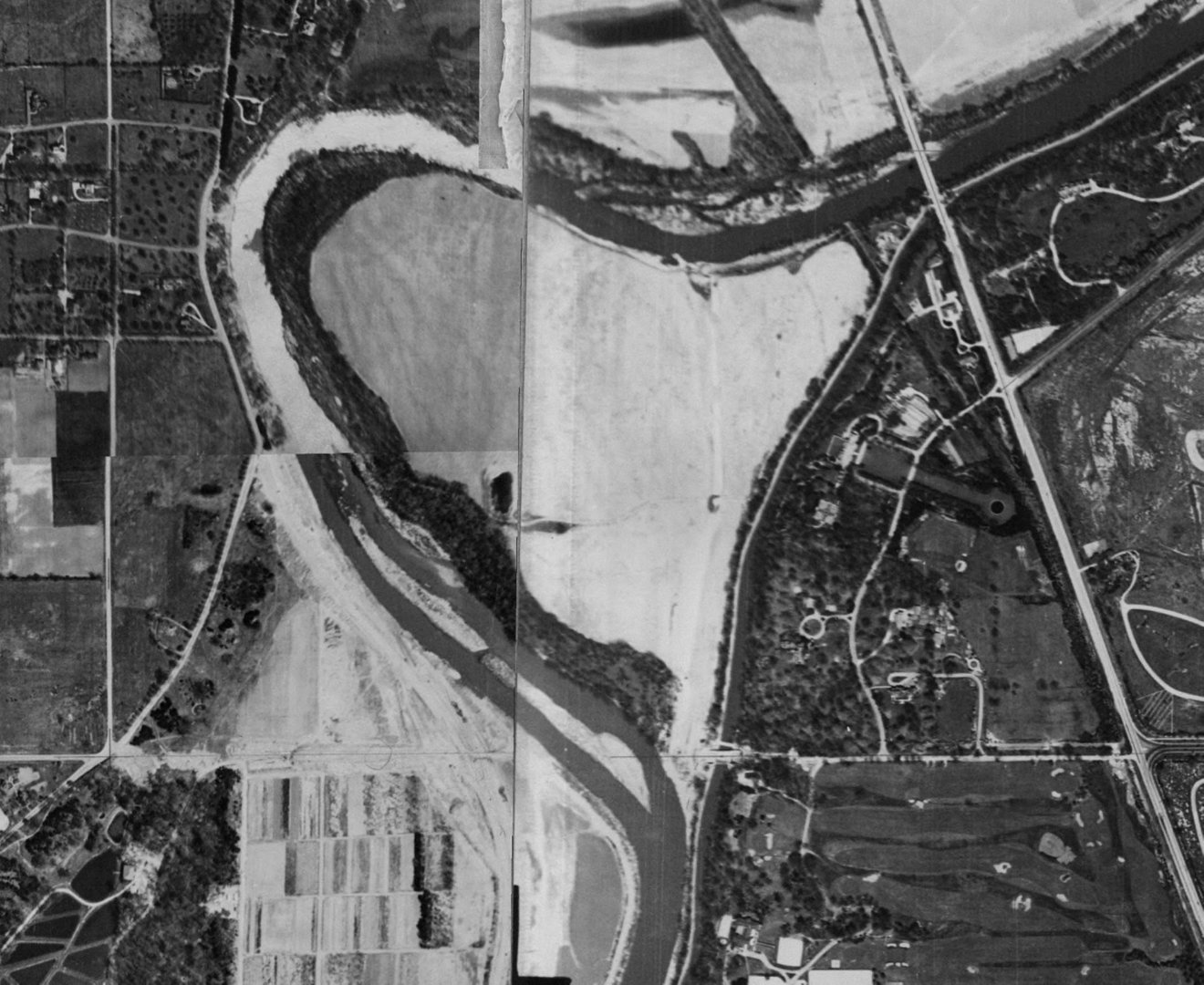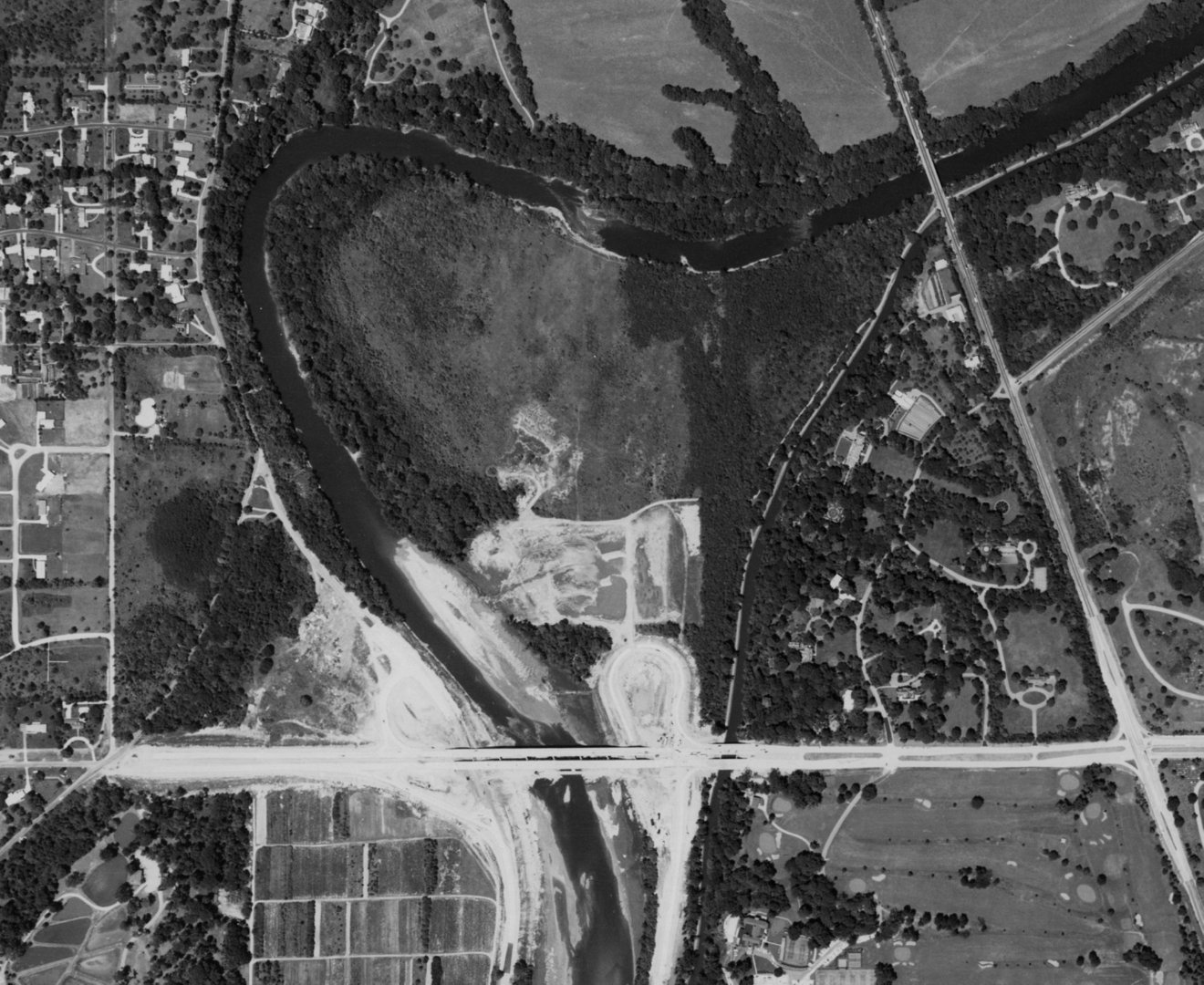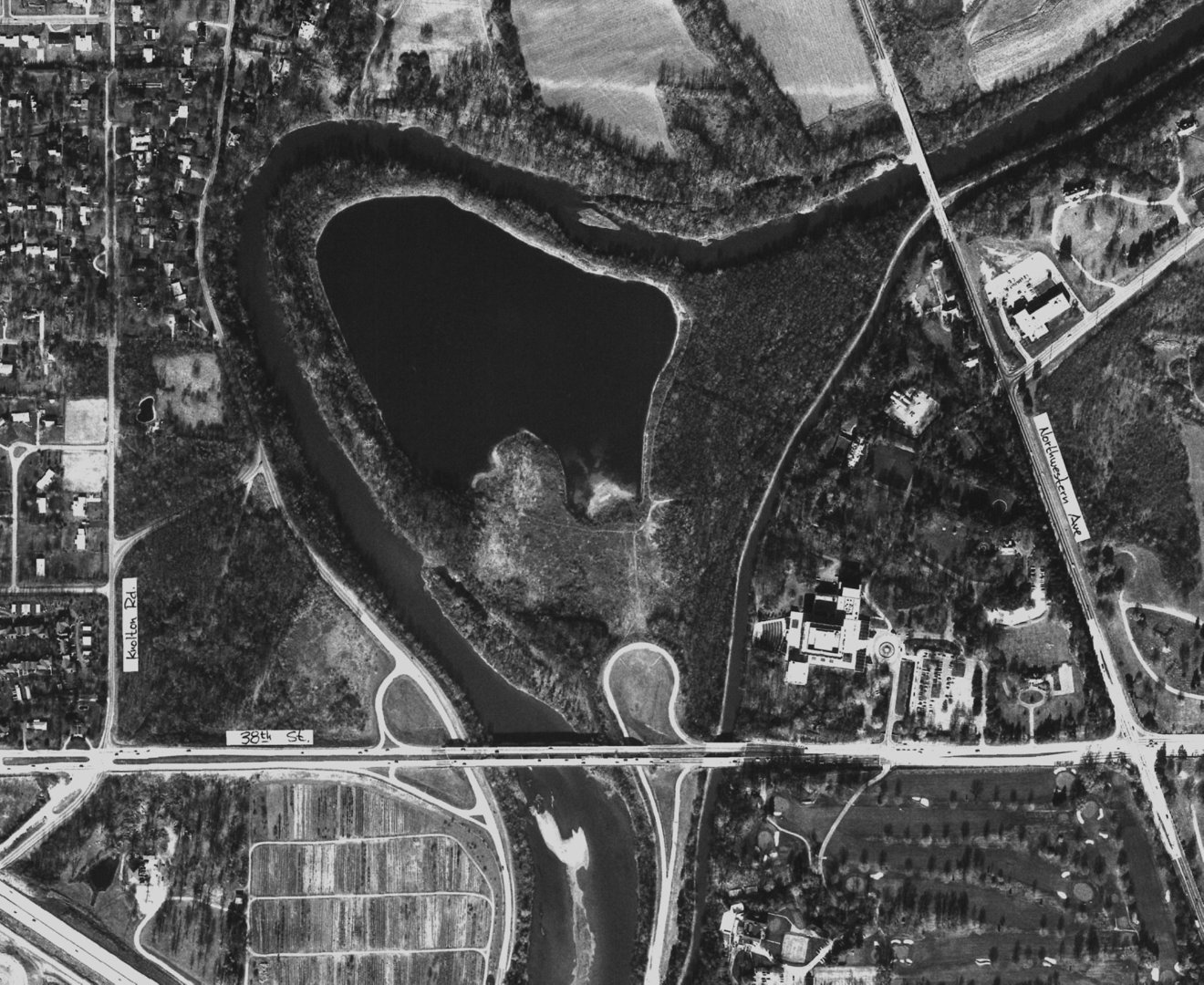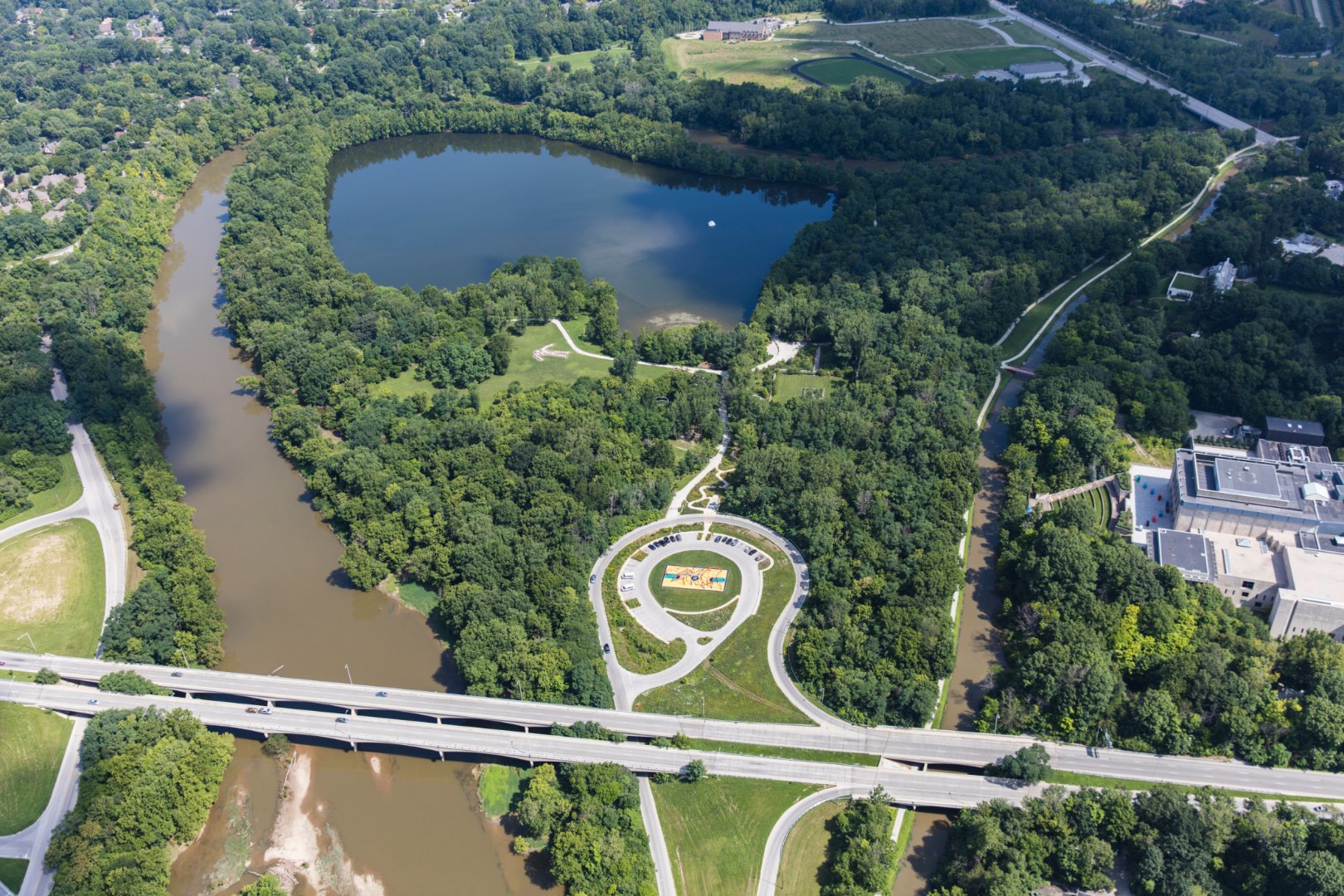Change is the foundation upon which The Virginia B. Fairbanks Art & Nature Park is built. From a gravel pit to living sculpture park, its history is vast and varied. Although humankind inevitably has an impact on the natural landscape, nature’s reaction and resilience is evident in our surroundings. Ecological succession, the process by which the mix of species and habitat in an area change over time, is confirmation of this resilience and visitors have an opportunity to witness how this land responds to change. The park has been many things throughout history but remains a steadfast reminder of the importance of responsible stewardship in our world.
A product of its environment
The physical terrain of the park, which is continuously growing and adapting, is notable for its variety—it embraces woodlands and wetlands as well as a meadow, lake, river, and canal. Situated in a floodplain that is defined by the distinctive curve of the White River on one side and the straight form of the human-made canal on the other, its landscape is shaped by the dynamic character of the water that runs through it. As a floodplain, it is a place of constant change, as the lake rises and falls through the seasons with the river's flow.
Change as the only constant
In the early 1900s this land was cleared for agricultural use and was used by farmers for cultivation of crops and pasture through the 1940s. Later the site became a quarry and gravel was excavated for use in the construction of the nearby I-465 highway, part of the network of superhighways that connect the country (and which relate to Indianapolis' nickname, "The Crossroads of America"). The lake was created as a result of the mining excavations.
After the completion of the highway, the land was abandoned and nature slowly reclaimed it, turning cleared fields into woodland. Ecological succession became evident as pioneer plants, including exotic invasives, repopulated the area. In the past two decades, work began to remove the invasive species and to encourage native growth to return to the site.
The question of the “island” property

The 1970s were marked by a reawakening of interest in the value of parks and parkways to the quality of life in Indianapolis. In 1972, as part of that trend, 96 acres of White River floodplain were given to the Indianapolis Museum of Art by the firm Huber, Hunt and Nichols, which had operated the quarry there. This was shortly after the Museum was given the Oldfields property and decided to move there from its old location on 16th street. The new land, lying in the White River corridor, an area the City of Indianapolis intended to develop for public recreational use, came to be called the “island” property.
Thoughts about how to best use the “island” germinated slowly until the late 1990s, when the idea of developing an art and nature park was born. For instance, in the mid-1980s, the IMA’s Horticultural Society initiated the creation of a master plan for the landscape of the Museum campus. While the land and gardens immediately adjoining the main Museum building and Lilly House were the initial focus of development, in 1996 the strategic plan called for a sculpture park, which would capitalize on the expanse of land that had not yet been fully utilized by the Museum up to that point. This paralleled the development of the city’s greenways plan, and the IMA joined with Indy Parks Greenways and the Indianapolis Water Company to form a partnership to develop a nature trail and an art and nature park.
In 2003 Edward Blake Jr. of The Landscape Studio in Hattiesburg, Mississippi, and Marlon Blackwell of Marlon Blackwell Architects in Fayetteville, Arkansas, were selected to design the project because of their poetic responses to the natural and built environment as well as their commitment to creating an environmentally responsible building. Besides the architects, the park’s development included extensive staff, board, and community involvement. Transforming this low-lying land situated between a great bend in the White River and a nineteenth-century canal into a remarkable art and nature park was a multimillion-dollar project to which many people contributed.
Watershed moment: The Richard M. Fairbanks Foundation’s contribution
It was the Richard M. Fairbanks Foundation that made the park a reality. Mr. Fairbanks was the founder of Fairbanks Communications, which owned and operated 20 radio stations around the country. He had served on the Museum’s board and was very generous to the institution during his lifetime. Upon his death in 2000 the bulk of his fortune went to the Richard M. Fairbanks Foundation, which awarded a $4 million grant to the Museum in 2001 to develop the park. The Fairbanks Foundation has provided a total $25 million to support the Virginia B. Fairbanks Art and Nature Park in honor of Mr. Fairbanks’s wife of 32 years, Virginia, who loved gardens and nature.
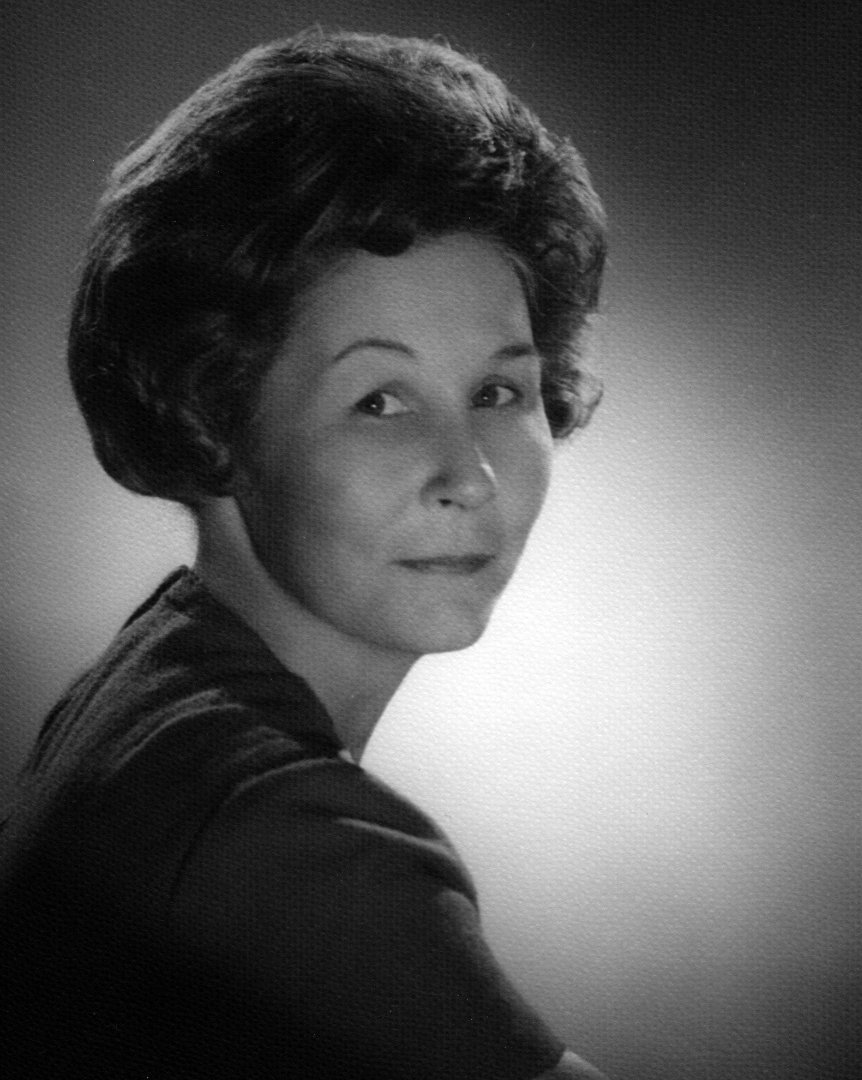
Who was Virginia B. Fairbanks?
Virginia B. Fairbanks (1923–2007) was raised by her grandparents Meredith Nicholson, Hoosier author and diplomat, and Eugenie Kountze Nicholson, an avid gardener who championed women’s suffrage and was active in the War relief. Her grandfather’s artistic vision and grandmother’s passion for gardening engendered in young Virginia a love of nature that would spark her own gardening interests in the years to come. Virginia’s daughter fondly recalls, “She loved beautiful things, she loved the outdoors, and she never minded getting her hands dirty.”
Virginia received her B.S. degree from Indiana University, where she went by the nickname “Gingy.” After marrying Mr. Fairbanks, Virginia had an active life of service and sociability, including as a member of the Indianapolis Garden Club, the Garden Club of America, the Junior League, and the Woodstock Club. Her lifelong passion for gardening was celebrated by the construction of The Virginia B. Fairbanks Art & Nature Park, as it was through the establishment of The Virginia Fairbanks Sun Garden at the Indianapolis Zoo. These gifts were made possible through the generosity of the Richard M. Fairbanks Foundation after her many years of service on the Fairbanks Foundation Board of Directors.
Designing The Park’s future
In reconceiving the vision of The Virginia B. Fairbanks Art & Nature Park, Newfields sought to find a way to not only offer residents of the city a space in the urban landscape where they could experience the pleasure of being immersed in nature and art, but to also offer a new paradigm for what an art and nature park could be.
Landscape architect Edward L. Blake Jr. was brought in to carve out pathways that would allow visitors to explore the variety of natural beauty that could be found there. Calling the pathways, he designed "Landscape Journeys," Blake draws attention to the sense of discovery that is offered throughout The Park's varied topography. Architect Marlon Blackwell's Ruth Lilly Visitor Pavilion offers a unique experience of The Park as well, with its architecture embracing the environment around it in unique ways. With its environmentally responsible LEED-certified design, it also serves as a model of thoughtful building practices.
The model of how art would be presented in the park was conceived by then senior curator of contemporary art Lisa Freiman (who worked at the Museum between 2002 and 2013) in the early 2000s; she, along with curators Sarah Green and Rebecca Uchill, worked together to create the first sculpture park in the United States to focus solely on commissioned temporary and permanent site-responsive artworks. The notion of site-specific art has played an especially important role in contemporary art since the 1960s, when Minimalists, Conceptualists, and Land Artists began thinking more about the physical environment for their works including galleries, museums, public venues, and eventually the landscape itself.





